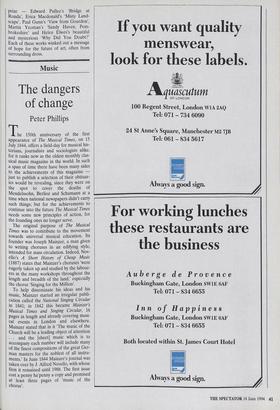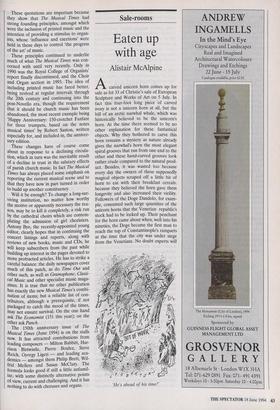Mu s i c
The dangers of change
Peter Phillips
The 150th anniversary of the first appearance of The Musical Times, on 15 July 1844, offers a field-day for musical his- torians, journalists and sociologists alike, for it ranks now as the oldest monthly clas- sical music magazine in the world. In such a span of time there have been many sides to the achievements of this magazine just to publish a selection of their obituar- ies would be revealing, since they were on the spot to cover the deaths of Mendelssohn, Berlioz and Schumann at a time when national newspapers didn't carry such things; but for the achievements to continue into the future The Musical Times needs some new principles of action, for the founding ones no longer serve.
The original purpose of The Musical Times was to contribute to the movement towards universal musical education. Its founder was Joseph Mainzer, a man given to writing choruses in an edifying style, intended for mass circulation. Indeed, Nov- ello's A Short History of Cheap Music (1887) states that Mainzer's choruses 'were eagerly taken up and studied by the labour- ers in the many workshops throughout the length and breadth of the land,' especially the chorus 'Singing for the Million'.
To help disseminate his ideas and his music, Mainzer started an irregular publi- cation called the National Singing Circular in 1841; in 1842 this became Mainzer's Musical Times and Singing Circular, 16 pages in length and already covering musi- cal events in London and elsewhere. Mainzer stated that in it 'The music of the Church will be a leading object of attention — and the [sheet] music which is to accompany each number will include many of the finest compositions of the great Ger- man masters for the noblest of all instru- ments.' In June 1844 Mainzer's journal was taken over by J. Alfred Novello, with whose firm it remained until 1988. The first issue cost a penny ha'penny a copy and promised at least three pages of 'music of the chorus'. These quotations are important because they show that The Musical Times had strong founding principles, amongst which were the inclusion of printed music and the intention of providing a stimulus to organ- ists, whose 'influence and exertions' were held in those days to control 'the progress of the art' of music.
These principles continued to underlie much of what The Musical Times was con- cerned with until very recently. Only in 1990 was the Royal College of Organists' report finally discontinued, and the Choir and Organ section in 1993. The idea of including printed music has fared better, being revived at regular intervals through the 20th century and continuing into the post-Novello era, though the requirement that it should be church music has been abandoned, the most recent example being `Happy Anniversary: 150-crotchet Fanfare for three trumpets, based on the notes musical times' by Robert Saxton, written especially for, and included in, the anniver- sary edition.
These changes have of course come about in response to a declining circula- tion, which in turn was the inevitable result of a decline in trust in the salutary effects of parish church music. In fact The Musical Times has always placed some emphasis on reporting the current musical scene and to that they have now in part turned in order to build up another constituency.
Will it be enough? To change a long-sur- viving institution, no matter how worthy the motive or apparently necessary the rea- son, may be to kill it completely, a risk run by the cathedral choirs which are contem- plating the admission of girl choristers. Antony Bye, the recently-appointed young editor, clearly hopes that in continuing the concert listings and reports, along with reviews of new books, music and CDs, he will keep subscribers from the past while building up interest in the pages devoted to more protracted articles. He has to strike a careful balance: the daily newspapers cover much of this patch, as do Time Out and other such, as well as Gramophone, Classi- cal Music and other specialist music maga- zines. It is true that no other publication has exactly the new Musical Times's combi- nation of items; but a reliable list of con- tributors, although a prerequisite, if not packaged to catch the mood of the times, may not ensure survival. On the one hand ask The Economist (151 this year); on the other ask Punch.
The 150th anniversary issue of The Musical Times (June 1994) is on the stalls now. It has attracted contributions from leading composers — Milton Babbitt, Har- rison Birtwistle, Pierre Boulez, Steve Reich, Gyorgy Ligeti — and leading aca- demics — amongst them Philip Brett, Wil- frid Mellers and Susan McClary. The formula looks good if still a little unfamil- iar, with some distinctly alternative points of view, current and challenging. And it has nothing to do with choruses and organs.



























































 Previous page
Previous page